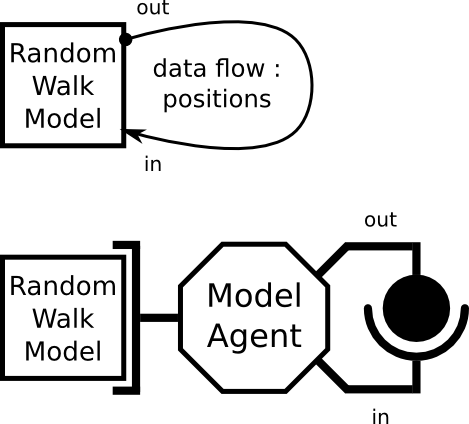In this tutorial, we present the operation we take on the positions in order for the walkers not go outside the boundaries of the model.


/**
* This class represents an operation which goal is to change the positions
* (x,y) of the Netlogo turtles when they reach the borders (defined by
* environment width and height)
*
* @author Julien Siebert
*/
public class PositionsLimitOp implements Operation {
/**
* Environment width (in order to replace the agents when they are out).
*/
private int environmentWidth;
/**
* Environment height (in order to replace the agents when they are out).
*/
private int environmentHeight;
/**
* Constructor
* @param width
* @param height
*/
public PositionsLimitOp(int width, int height) {
environmentHeight = height;
environmentWidth = width;
}
public SimulData apply(SimulData someKindOfData) {
// the list of new positions to return
HashMap<Double, Point2D.Double> newPositionList = new HashMap<Double, Point2D.Double>();
// check if the class of the simulData is correct (i.e. correspond to
// the TurtlePosition Class)
if (someKindOfData.getClass().equals(TurtlePositions.class)) {
// get the initial list of positions
TurtlePositions pos = (TurtlePositions) someKindOfData;
HashMap<Double, Point2D.Double> oldPositionList = pos
.getTurtlePositions();
// limit the turtle positions
for (Double turtleID : oldPositionList.keySet()) {
// get the initial positions
Point2D.Double aPosition = oldPositionList.get(turtleID);
// limit the initial position (if needed)
aPosition = operation(aPosition);
// fill the resulting hashMap (I.e. the new list of new
// positions)
newPositionList.put(turtleID, aPosition);
}
} else {
// exit.
System.err
.println("trying to take an operation on a non turtle position data");
System.exit(666);
}
// the simulData to return
SimulData res = new TurtlePositions(newPositionList);
return res;
}
/**
* This is an example of operation we can take on the set of input data. In
* this example when an agent is outside the environment boundaries (width
* and height), then its position is set to the origin (0,0).
*
* @param aPosition
* @return
*/
private Point2D.Double operation(Point2D.Double aPosition) {
Point2D.Double newPosToReturn = aPosition;
if ((aPosition.getX() < (-environmentWidth / 2))
|| (aPosition.getX() > (environmentWidth / 2))
|| (aPosition.getY() < (-environmentHeight / 2))
|| (aPosition.getY() > (environmentHeight / 2))) {
newPosToReturn.y = 0;
newPosToReturn.x = 0;
}
return newPosToReturn;
}
public int getEnvironmentWidth() {
return environmentWidth;
}
public int getEnvironmentHeight() {
return environmentHeight;
}
}